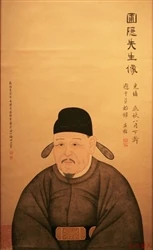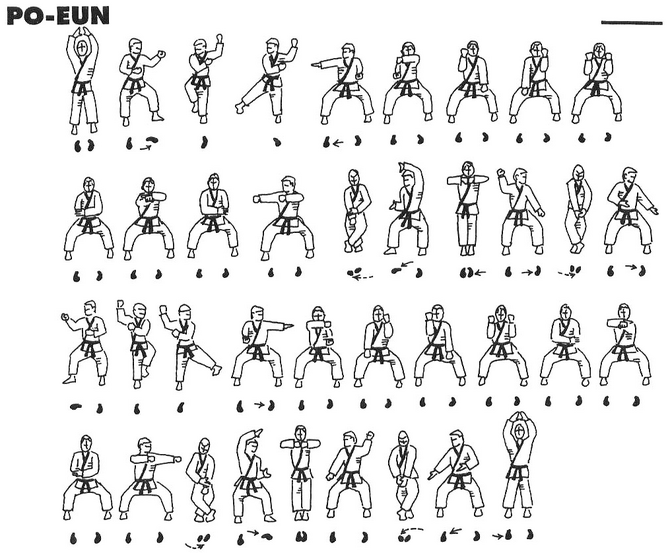
Chong Mong Chu

Sonjuk Bridge, where Chu was assasinated
Po-Eun is one of three 1st degree black belt forms learned in ITF-style taekwondo. The form has 36 movements. Po Eun is the pseudonym of a fifteenth century Korean poet and scientist named Chong Mong Chu. Chong is revered as a great patriot, having penned the famous lines "I would not serve a second master, though I might be crucified a hundred times." The movement in this form denotes his unerring loyalty to the king and country towards the end of the Koryo Dynasty.
Chong Mong Chu lived during the Koryo Dynasty and became a trusted servant to the king, who had much confidence in his broad knowledge and good judgement. Chong also visited Japan and China as a diplomat on behalf of his king. He participated in many national projects and also founded an institute devoted to the theories of Confucianism. He was also a pioneer in the field of physics.
Yi Sung Gae (the first king of the Yi Dynasty) tried many times to persuade Chong to join him, but Chong refused, penning a poem:
- Even if, I may die, die a hundred times,
- Even if my skeleton may become dust and dirt,
- And whether my spirit may be there or not,
- My single-hearted loyalty to the lord will not change.
This convinced Yi that Chong could not be swayed. On 4th April 1392, Yi sent an assassin to Sonjuk Bridge to kill Chong with an iron hammer. The death of Chong Mong Chu was seen as the catalyst to the eventual overthrowing of the Koryo Dynasty in July 1392.
Sonjuk Bridge is now seen a symbol of loyalty by the Korean people. There are several memorials dedicated to Chong Mong Chu, including the Hama monument, which requires that all passers-by should dismount from their horses as they pass.
Video[]
Why was this video chosen for use on this wiki? Do you have a better video? Please see Video Guidelines before replacing this video with a better one.
Diagram[]
Written Instructions[]

The lines of Po-Eun (student view)
Here on this wiki, the wording used to describe this form deviates from the conventional wording historically used to describe the form. This was done to facilitate wiki-style links to the names of associated techniques. To view the conventional wording, see ITF Forms Summary Description.
- Ready Posture: Parallel Stance with a Heaven Hand
- 1. Step the left foot toward B, forming a Right L-Stance (i.e, left foot forward) facing B. Middle Guarding Block to B.
- 2. Pull the right foot to the left knee joint to form a Left One-Legged Stance facing D, at the same time lifting both fists, while turning the face toward A.
- 3. Execute a Left Pressing Kick to A, keeping the position of the hands as they were in 2.
- 4. Lower the right foot to A to form a Sitting Stance facing D. Right Middle Knifehand Side Strike to A.
- 5. Execute an angle punch, while maintaining a Sitting Stance facing D.
- Perform 6 through 12 in a continuous motion:
- 6. Execute a Left Forefist Pressing Block with a Right Inner Forearm Side Front Block, while maintaining a Sitting Stance facing D.
- 7. Execute a Right Forefist Pressing Block with a Left Inner Forearm Side Front Block, while maintaining a Sitting Stance facing D.
- 8. Execute a middle Inner Forearm Wedging Block, while maintaining a Sitting Stance facing D.
- 9. Right Rear Elbow Thrust to C, supporting the right fist with the left palm, keeping the face as it was in 8, while maintaining a Sitting Stance facing D.
- 10. Execute a Right Middle Punch to D, sliding the left palm up to the right elbow joint, while maintaining a Sitting Stance facing D.
- 11. Thrust to C with the left back elbow supporting the left forefist with right palm, keeping the face as it was in 10, while maintaining a Sitting Stance facing D.
- 12. Execute a Right Horizontal Punch to A, while maintaining a Sitting Stance facing D.
- 13. Cross the left foot over the right foot forming a Right X-Stance (cross stance) facing D. Low Front Block to D and bring the left fingers (i.e., the pads of the fingers) onto the right underside of the forearm.
- 14. Step the right foot toward A into a Left L-Stance (i.e, right foot forward) facing A, at the same time executing a U-Shaped Grasp to A.
- 15. Bring the left foot to the right foot forming a Closed Stance facing D. Twin Elbow Horizontal Thrust, turning the face toward B. Perform slowly.
- 16. Step the left foot toward B to form a Sitting Stance facing D. Right Backfist Side Strike to C and bring the extended left arm downward to the side.
- 17. Cross the right foot over the left foot forming a Left X-Stance (cross stance) facing D. Left Outer Forearm Low Front Block and bring the right fingers (i.e., the pads of the fingers) to the left side fist.
- 18. Step the left foot toward B to form a Sitting Stance facing D. Low Ridgehand Guarding Block to B.
- 19. Execute a forearm Middle Guarding Block to A, pivoting with the left foot into a Left L-Stance (i.e, right foot forward) facing A.
- 20. Pull the left foot to the right knee joint to form a Right One-Legged Stance facing D, at the same time lifting both fists, while turning the face toward B.
- 21. Execute a Right Pressing Kick to B keeping the position of the hands as they were in 20.
- 22. Lower the left foot to B to form a Sitting Stance facing D. Right Middle Knifehand Side Strike to B.
- 23. Execute an Right Angle Punch, while maintaining a Sitting Stance facing D.
- Perform 24 through 30 in a continuous motion:
- 24. Execute a Right Forefist Pressing Block. Left Inner Forearm Side Front Block, maintaining a Sitting Stance facing D.
- 25. Execute a Left Forefist Pressing Block and a Right Inner Forearm Side Front Block, while maintaining a Sitting Stance facing D.
- 26. Execute a middle Inner Forearm Wedging Block, while maintaining a Sitting Stance facing D.
- 27. Thrust to C with the left back elbow supporting the left forefist with the right palm keeping the face as it was in 26, while maintaining a Sitting Stance facing D.
- 28. Execute a Left Middle Punch to D, sliding the right palm up to the left elbow joint, while maintaining a Sitting Stance facing D.
- 29. Thrust to C with the right back elbow supporting the right forefist with left palm, keeping the face as it was in 28, while maintaining a Sitting Stance facing D.
- 30. Execute a Left Horizontal Punch to B, while maintaining a Sitting Stance facing D.
- 31. Cross the right foot over the left foot forming a Left X-Stance (cross stance) facing D. Left Low Outer Forearm Front Block to D and bring the right fingers (i.e., the pads of the fingers) on the left underside of the forearm.
- 32. Step the left foot toward B into a Right L-Stance (i.e, left foot forward) facing B at the same time executing a U-Shaped Grasp to B.
- 33. Bring the right foot to the left foot forming a Closed Stance facing D. Twin Elbow Horizontal Thrust, turning the face toward A. Perform slowly.
- 34. Step the right foot toward A to form a Sitting Stance facing D. Right Backfist Side Strike to C and bring the extended right arm downward to the side.
- 35. Cross the left foot over the right foot forming a Right X-Stance (cross stance) facing D. Right Low Outer Forearm Front Block and bring the left fingers (i.e., the pads of the fingers) to the right side fist.
- 36. Step the right foot toward A to form a Sitting Stance facing D. Low Ridgehand Guarding Block to A.
- End: Bring the foot back to the ready position.
Black Belt Forms[]
The ITF-style Black Belt forms are:
- Kwang-Gae (39 movements) - 1st dan
- Po-Eun (36 movements) - 1st dan
- Ge-Baek (44 movements) - 1st dan
- Eui-Am (45 movements) - 2nd dan
- Choong-Jang (52 movements) - 2nd dan
- Juche (45 movements) - 2nd dan / Ko-Dang* (39 movements) - 2nd dan
- Sam-Il (33 movements) - 3rd dan
- Yoo-Sin (68 movements) - 3rd dan
- Choi-Yong (46 movements) - 3rd dan
- Yon-Gae (49 movements) - 4th dan
- Ul-Ji (42 movements) - 4th dan
- Moon-Moo (61 movements) - 4th dan
- So-San (72 movements) - 5th dan
- Se-Jong (24 movements) - 5th dan
- Tong-Il (56 movements) - 6th dan
Forms no longer used:
* Ko-Dang is an older form, replaced with Juche. Ko-Dang is still taught in some schools however.
U-Nam is an ITF/Chang Hon-style form that appears only in the 1959 edition of Choi Hong Hi's Tae Kwon Do Teaching Manual.
References[]
The primary reference is:
The following websites are also particularly good online references for ITF-style taekwondo:

